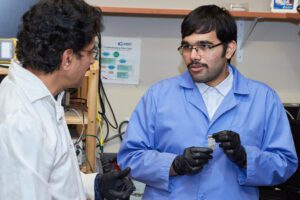The sun is an abundant — but still largely untapped — energy source.
With the push for renewable energy, researchers from Clemson University and the Indian Institute of Science have designed a smart supercapacitor using a novel stack of metal oxides — vanadium pentoxide and zinc oxide — that can efficiently harvest energy from sunlight and simultaneously store it.
Like batteries, supercapacitors store and release electricity. But unlike batteries, supercapacitors don’t need a chemical reaction to store energy. Instead, electric charge is stored electrostatically, which allows supercapacitor to be rapidly charged and discharged. The research could pave the way for future self-charging consumer electronics such as health monitoring devices.

Although solar energy is renewable, one challenge is that it is harvested during the day when the sun is out and must be stored for future use. That traditionally required two separate devices — one to harvest the light into electricity and another to store it. Having both makes the overall system bulky. The researchers from the lab of Indian Institute of Science Professor Abha Misra and the Clemson Nanomaterials Institute (CNI) developed a smart device that converts light to electrical energy and stores it, reducing bulkiness.
Zinc oxide has been widely used in light-dependent charge transfer applications, such as photovoltaics and photocatalysis, because of its low cost, high carrier mobility, long carrier diffusion, ease of synthesis on substrates and non-toxicity. It has electron transporting and hole-blocking characteristics and readily generates photo-excited electrons on light irradiation. However, its wide band gap restricts its utility to a narrow light spectrum, requiring a novel strategy to improve its performance.
Unique structure

The researchers stacked vanadium pentoxide and zinc oxide to create a unique heterostructure, one which improved on past materials’ ability to convert light to electrical energy. In a test to measure its ability to store harvested light, the new device bested the previous record by a factor of four.
“We’ve come up with a two-in-one device that not only harvests light more efficiently but also stores it as electrical energy, unlike the other systems that exist right now,” said Mihir Parekh, a postdoctoral fellow in the Department of Physics and Astronomy and a researcher at CNI. “The materials we chose allowed us to engineer the band gap so that the light-to-electricity conversion was very efficient.”
The researchers found that the device showed excellent electrochemical performance and stability for over 5,000 cycles.
Driving force
“What we are essentially doing here is trying to harvest every ounce of energy around us in nature,” said Apparao Rao, CNI’s founding director and the R.A. Bowen Professor of Physics in the College of Science’s Department of Physics and Astronomy. “We have much sunlight. The driving force behind the research is to open doors to another technology besides solar cells, which has already become a mature field, to capture the energy that is all around us.”
The Journal of Materials Chemistry A published the findings in a paper titled “Stacked vanadium pentoxide-zinc oxide interface for optically-chargeable supercapacitors.” Journal editors selected it as a 2022 HOT paper.
This collaborative research was funded by the Indo-U.S. Science and Technology Forum Grant Number IUSSTF/JC-146/2019.
The College of Science pursues excellence in scientific discovery, learning, and engagement that is both locally relevant and globally impactful. The life, physical and mathematical sciences converge to tackle some of tomorrow’s scientific challenges, and our faculty are preparing the next generation of leading scientists. The College of Science offers high-impact transformational experiences such as research, internships and study abroad to help prepare our graduates for top industries, graduate programs and health professions. clemson.edu/science
Get in touch and we will connect you with the author or another expert.
Or email us at news@clemson.edu
